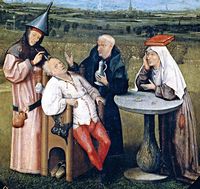
Photo from wikipedia
Background/purpose Acemannan, a β-(1–4)-acetylated polymannose extracted from Aloe vera gel, has been proposed as biomaterial for bone regeneration. The aim of this study was to investigate the effect of acemannan… Click to show full abstract
Background/purpose Acemannan, a β-(1–4)-acetylated polymannose extracted from Aloe vera gel, has been proposed as biomaterial for bone regeneration. The aim of this study was to investigate the effect of acemannan in calvarial defect healing. Materials and methods Acemannan was processed to freeze-dried sponge form and disinfected by UV irradiation. Thirty-five female Sprague–Dawley rats were used in the in vivo study. Seven-mm diameter mid-calvarial defects were created and randomly allocated into blood clot control (C), acemannan 1 mg (A1), 2 mg (A2), 4 mg (A4), and 8 mg (A8) groups (n = 7). After four weeks, the calvarial specimens were subjected to microcomputed tomography (microCT) and histopathological analysis. Results MicroCT revealed a significant increase in bone surface and bone volume in the A1 and A2 groups, and tissue mineral density in the A4 and A8 groups compared with the control group (p < 0.05). Histologically, the acemannan-treated groups had denser bone matrix compared with the control group. Conclusion Acemannan is an effective bioactive agent for bone regeneration, enhancing bone growth as assayed in two- and three-dimensions.
Journal Title: Journal of Dental Sciences
Year Published: 2018
Link to full text (if available)
Share on Social Media: Sign Up to like & get
recommendations!